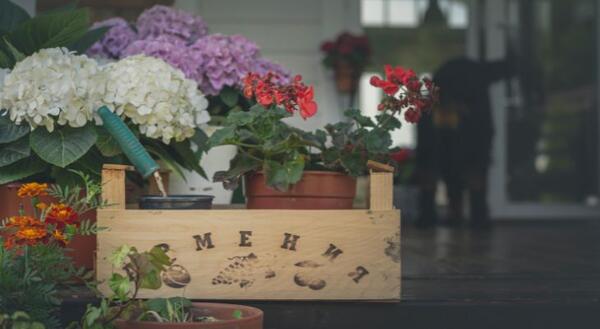
Keep your thumb green this winter by caring for beloved garden plants indoors. The chill of winter may seem far off, but the threat of frost is nearly here. On average, the first frost in Central Illinois is mid-October, but it can occur sooner. Act now - move your favorite garden plants indoors before a damaging frost.
And with a little time and care, overwintering a selection of your best garden performers indoors will save money and fill your garden next spring.
1. Choose the Right Plants
Before loosening, then lifting, every garden plant, consider which specimens are ideal for overwintering. Tender perennials, tropical plants, and some herbs easily overwinter in conditions preferred by houseplants.
Try overwintering these plants
- Tender perennials: Geranium, coleus, lantana, begonia, Persian shield, and Joseph’s coat.
- Tropical plants: cordyline, gardenia, and croton.
- Herbs: sage, rosemary, and bay.
Not only will this selection of overwintered plants reduce your garden budget next year, but the green additions indoors will also be uplifting midwinter.
2. Choose Healthy Plants
When selecting favorites for a winter indoors, select only healthy specimens. Inspect each plant carefully for signs of pests and disease. Rinse leaves with a stream of water to remove tiny hiding insects and consider treating plants with insecticidal soap as a precautionary measure.
3. Move Plants Carefully
To move plants indoors, dig up the entire plant, then pot in a container of fresh potting soil. When digging, take care to keep most of the root system intact which will reduce stress on the plant.
Cutting back the plant’s foliage by one-third will also support a healthy transition, allowing the plant to focus on root repair instead of sustaining mature top growth.
Care for overwintered garden plants just like a houseplant: place in a sunny location, water when dry, and supply a source of humidity, such as a shallow pan of gravel and water underneath the container.
4. Try Propagating Plants
If space indoors is limited, try propagating your favorite plants. This process gifts new plants from existing plants.
- Select a healthy, 3 to 5-inch shoot with four to six leaves attached.
- Cut directly below a leaf attachment — where the leaf is attached to the stem (node). Take several cuttings to ensure the survival of a viable plant.
- Remove flowers, buds, and the bottom two to four leaves from the cutting.
- Insert the lower portion of the cutting into a container of damp potting soil.
- Cover the entire container with clear plastic to maintain high humidity while roots are forming and place the container in bright, indirect light.
After three to four weeks, the cutting should have developed a young root system and the plastic cover should be removed. Care for the plant uncovered for the winter season.
Some plants are challenging to propagate. Consider learning with coleus, begonias, and impatiens.
5. Say Hello to Spring
When spring arrives, gradually acclimate plants to outside weather by setting them on a patio or driveway during the day once daytime temperatures are above 60°F. Plants can remain outside, and return to the garden, once the threat of frost has passed.
Photo credit: Egor Myznik on Unsplash
ABOUT THE AUTHOR: Brittnay Haag is a Horticulture Educator with University of Illinois Extension, serving Livingston, McLean, and Woodford Counties. Her work focuses on youth horticulture education, specifically through school gardens and Jr. Master Gardener programs. Brittnay provides leadership for three county Master Gardener programs and is responsible for developing community programs and providing expertise in horticulture and environmental sciences.